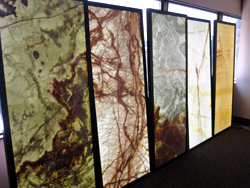5 (Ok, 6!) Reasons for Designers To Love Natural Stone Panels
 As the counterpoint to our blog post “5 Reasons For Designers To Love Faux Stone Panels”, today we take on the alternate perspective and illustrate the benefits of natural stone panels. Given that this succeeding post quickly catapulted to twelve points, which I narrowed to six here, it’s pretty clear which material we regard as a superior architectural solution.
As the counterpoint to our blog post “5 Reasons For Designers To Love Faux Stone Panels”, today we take on the alternate perspective and illustrate the benefits of natural stone panels. Given that this succeeding post quickly catapulted to twelve points, which I narrowed to six here, it’s pretty clear which material we regard as a superior architectural solution.
Here are the criteria which make glass-backed natural stone panels a superior architectural solution:
1. Backlighting and optical clarity
When backlighting panels for feature areas, natural translucent stone panels take on a sparkling appearance that is a result of the crystalline graining that formed in the stone over thousands (or millions) of years. With glass-backed exotic stones, such as onyx, the stone layer can be thinned from 1 mm to 12 mm, allowing much light but still retaining the visual effect of naturally layered depth. Most man-made faux stone panels tend to lack natural depth, appearing flat and dull when illuminated with a backlighting source.
2. Large Panel Sizes
If you’re designing for a large scale installation or simply want to minimize joints, natural stone panels can be sourced in very large sizes. It depends on the variety of stone, but we’ve utilized exotic onyx and marble panels up to 5’ x 10’. Acrylic or poured resin stone panels tend to be limited to standard sheet sizes. Even if the man-made products are thickened to increase rigidity and yield a larger panel, the additional surface thickness interferes with light transmission. With glass-backed natural stone surfaces, larger panels are created by simply increasing the thickness of the glass backing, preserving the translucency of the stone layer at only millimeters thin.
3. Natural Variation
Acrylic and resin stone panels are standardized into existing collections, offering limited selections of coloration and patterning. Each panel has the same patterning, yielding repetitive images. By using natural stone panels, visual characteristics vary within the slab itself and across the larger scale, creating unique fluctuation within installations. Natural veins and movement are reflected as dynamic bookmatched images across panel joints.
4. Longevity
Natural stone is classic, elegant, and distinct. For quality design features that withstand time, natural stone panels open up the most possibilities in creating enduring spatial elements. Onyx panels sustain their quality, with no evidence of surface degradation over time and very little maintenance required.
5. Exterior use
To our knowledge, there are no translucent faux stone materials that are rated for exterior applications. Glass-backed natural stone can be used in exterior curtainwall applications and as part of insulated glazing units. This only holds true for high quality fabricators with thorough testing, so use discrimination when selecting a source for exterior panels.
6. Uniqueness
Real stone is a product of Mother Nature, and each slab for each project is unique unto itself. Your client becomes the proud owner of a truly unique work of art.
–> We would like to thank @whysideas for engaging in an interesting Twitter conversation in reaction to our first blog post. There’s something to be said for authenticity in architecture. Cheap materials and quick solutions show a sort of short-sightedness on the architect’s part, and if you’re not careful, technological capabilities can distort the appropriate contextual solution for a project. As @whysideas stated, “technological advances are so important but should give physicality to the architect’s imagination, not dictate it”. Our advice? Have some patience to allow your designs to unfold, and dedicate your time to implementing high quality materials that meet their intended use and will enhance the image of your space.
